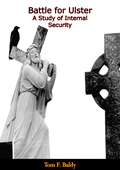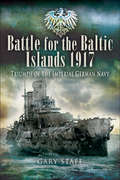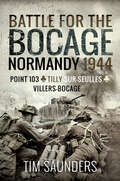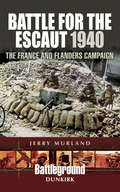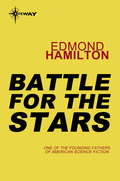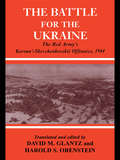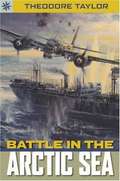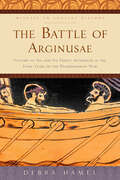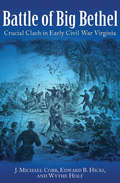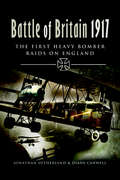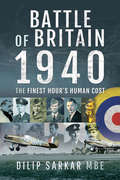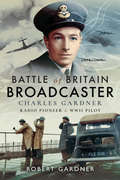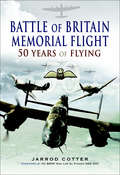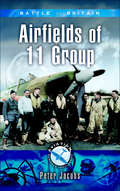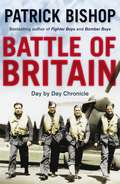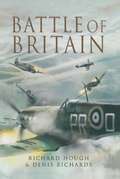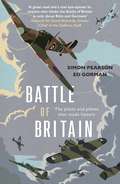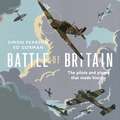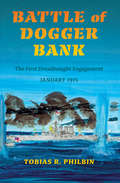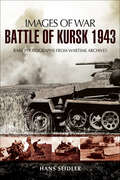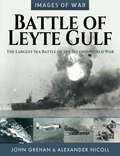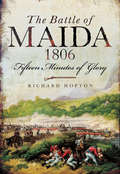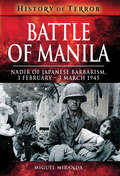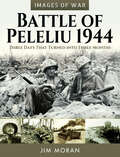- Table View
- List View
Battle for Ulster: A Study of Internal Security
by Tom F. BaldyAttention to the conflict in Northern Ireland is often pre-empted in North America by such other international problems as worldwide terrorism, eruptions in the Middle East, and insurgencies in Latin America. The Irish “troubles” seem to catch our attention primarily as headline events, such as the 1981 hunger strikes or the 1983 Christmas bombing of Harrod’s department store. Yet the protracted violence in Northern Ireland doesn’t cease between spectacular and heavily reported incidents—the violence continues daily. Indeed, since 1969, terrorist violence has killed more than 2,500 people and injured another 29,000.As Tom F, Baldy points out in this study, the British government’s internal security operation has sought for years to control the violence in Northern Ireland. To explain the existing situation, Mr. Baldy reviews the historical roots of the conflict, identifies its major factions, and outlines various options for its resolution. Baldy contends the British have managed, with their internal security operation, to limit open violence, but have failed to attain the ultimate objective: a workable, mutually acceptable political solution. Keeping that British goal in mind, Baldy speculates on Northern Ireland’s future.The “troubles” in Northern Ireland pose a continuing challenge to one of the United States’ most reliable and closest allies. The unique local issues aside, Britain’s effort to resolve the conflict within the United Kingdom nevertheless provides insights for people and governments confronting terrorism and guerrilla warfare in many other areas of the world, and reminds all of the dangers of factionalism for free governments.
Battle for the Baltic Islands, 1917: Triumph of the Imperial German Navy
by Gary Staff&“A very detailed operational account of the highly successful German amphibious landings in October of 1917 on the Russian islands of Osel and Dago.&”—The NYMAS Review In late 1917, the Russians, despite the revolution, were still willing to continue the war against Germany. This is an account of Operation Albion, the highly successful seaborne operation launched by the Germans to change their minds. The Baltic Islands were pivotal for the defense of the Finnish Gulf and St. Petersburg, so their capture was essential for any campaign towards the Russian capital. Only after the fall of the islands did Russia begin peace negotiations (freeing nearly half a million German soldiers for the Kaiser&’s last gamble on the Western Front). This then was a campaign of great significance for the war on both Eastern and Western fronts. A large part of the High Sea Fleet took part in the invasion of the Baltic islands, including the most modern dreadnought battleships. The Russians mounted a resolute defense despite being heavily outgunned and over a ten-day period there were many naval clashes around the islands as well as the campaign ashore, all of which are described in detail with the use of both Russian and German firsthand accounts. This book shatters the myth that the Imperial German Navy spent the last two years of the war cowering in port. &“Should be a blueprint for other military history books . . . The maps are some of the best I have seen in military books . . . The author tells the story of the campaign from the smallest mine sweeper to the various battleships involved.&”—A Wargamers Needful Things
Battle for the Bocage: The Fight for Point 103, Tilly-sur-Seulles, Vilers Bocage (Battleground Normandy Ser.)
by Tim SaundersThis WWII military study examines the combat experiences of three Allied divisions charged with spearheading the invasion of Normandy. To lead the charge into France after the Normandy landings, General Montgomery brought three veteran desert formations back from the Mediterranean. They were the 50th Infantry and 7th Armored divisions, plus 4th Armored Brigade. Their task beyond the beaches was to push south to Villers Bocage with armor on the evening of D-Day in order to disrupt German counter-attacks on the beachhead. Difficulties on 50th Division&’s beaches allowed time for German reinforcements to arrive in Normandy. As a result, 4th Armored Brigade was firmly blocked just south of Point 103 after an advance of less than five miles. A major counter-attack by Panzer Lehr failed, as did a renewed British attempt, this time by the vaunted 7th Armored Division, which was halted at Tilly sur Seulles. From here the fighting became a progressively attritional struggle in the hedgerows of the Bocage country south of Bayeux. More units were drawn into the fighting, which steadily extended west. Finally, an opportunity to outflank the German defenses via the Caumont Gap allowed 7th Armored Division to reach Villers Bocage. There then followed what the battalions of 50th Division describe as their &‘most unpleasant period of the war&’, in bitter fighting, at often very close quarters, for the &‘next hedgerow&’.
Battle for the Escaut, 1940: The France and Flanders Campaign
by Jerry MurlandOn 10 May 1940 the British Expeditionary Force (BEF), under the command of Lord Gort, moved forward from the Franco-Belgian border and took up positions along a 20-mile sector off the River Dyle, to await the arrival of the German Army Group B. Their expected stay was considerably shorter than planned as the German Army Group A pushed its way through the Ardennes and crossed the Meuse at Sedan, scattering the French before them. Little did the men of the BEF realise that the orders to retire would result in their evacuation from Dunkirk and other channel ports.The line of the River Escaut was seen as the last real opportunity for the Allied armies to halt the advancing German Army, but the jigsaw of defence was tenuous and the allied hold on the river was undone by the weight of opposing German forces and the speed of the armoured Blitzkrieg thrust further south. As far as the BEF were concerned, the Battle for the Escaut took place on a 30-mile sector from Oudenaarde to Blharies and involved units in a sometimes desperate defence, during which two Victoria Crosses were awarded. This book takes the battlefield tourist from Oudenaarde to Hollain in a series of tours that retrace the footsteps of the BEF. With the help of local historians, the author has pinpointed crucial actions and answered some of the myriad questions associated with this important phase of the France and Flanders campaign of 1940.
Battle for the Stars
by Edmond HamiltonIt was no place for man to be. Men were tissue, blood, bone, nerve. This place was not made for them. It was made for force and radiation. Go home, men.But I can't, thought Jay Birrel. Not yet...I have to go on into this place where a human being looks as pathetic as an insect in a furnace.
Battle for the Ukraine: The Korsun'-Shevchenkovskii Operation (Soviet (Russian) Study of War)
by Harold S. Orenstein David M. GlantzA comprehensive guide to the battle for the Ukraine from the Soviet perspective during the winter of 1943-1944. This volume is an unexpurgated translation of the originally classified Soviet General Staff Study No.14.
Battle in the Arctic Sea
by Theodore TaylorAmerica's most crucial mission was to provide arms and supplies to our English and Russian allies. Taylor, who served in the merchant marines in World War II, tells the tragic tale of a convoy of 33 ships that sailed from Iceland to Russia.
Battle in the Baltic: The Royal Navy and the Fight to Save Estonia & Latvia, 1918–1920
by Steve R Dunn Al RossThe little-known campaign to save Latvian and Estonian independence: "Anyone interested in naval operations is likely to find some useful food for thought.” —StrategyPageFor most participants, the First World War ended on November 11, 1918. But Britain’s Royal Navy found itself, after four years of slaughter and war weariness, fighting a fierce and brutal battle in the Baltic Sea against Bolshevik Russia in an attempt to protect the fragile independence of the newly liberated states of Estonia and Latvia.This book describes the events of those two years when Royal Navy ships and men, under the command of Rear Admiral Walter Cowan, found themselves in a maelstrom of chaos and conflicting loyalties, and facing multiple opponents—the communist forces of the Red Army and Navy, led by Leon Trotsky; the gangs of freebooting German soldiers, the Freikorps, intent on keeping the Baltic states under German domination; and the White Russian forces, bent on retaking Petrograd and rebuilding the Russian Empire. During this hard-fought campaign there were successes on both sides. For example, the Royal Navy captured two destroyers that were given to the Estonians; but the submarine L-55 was sunk by Russian warships, lost with all hands. Seeking revenge in a daring sequence of attacks and using small coastal motor boats, the RN sank the cruiser Oleg and badly damaged two Russian battleships.Today few people are aware of this exhausting campaign and the sacrifices made by Royal Navy sailors, but this book retells their exciting but forgotten stories and, using much firsthand testimony, bring back to life the critical naval operations that prevented the retaking of the new Baltic countries that Churchill saw as an essential shield against the encroachment of the Bolsheviks into Europe—and resulted in an uneasy peace that would prevail until 1939.
Battle of Arginusae: Victory at Sea and Its Tragic Aftermath in the Final Years of the Peloponnesian War (Witness to Ancient History)
by Debra HamelAn Athenian triumph against Sparta end in disaster and infamy in this naval history of Ancient Greece in the 5th century B.C.Toward the end of the Peloponnesian War, nearly three hundred Athenian and Spartan ships fought a pivotal skirmish in the Arginusae Islands. Larger than any previous naval battle between warring Greeks, the Battle of Arginusae was a crucial win for Athens. Its aftermath, however, was a major disaster for its people.Due to numerous factors, the Athenian commanders abandoned the crews of twenty-five disabled ships. Thousands of soldiers were left clinging to wreckage and awaiting help that never came. When the failure was discovered back home, the eight generals in charge were deposed. Two fled into exile, while the other six were tried and executed.In The Battle of Arginusae, historian Debra Hamel describes the violent battle and its horrible aftermath. Hamel introduces readers to Athens and Sparta, the two thriving superpowers of the fifth century B.C. She provides a summary of the events that caused the long war and discusses the tactical intricacies of Greek naval warfare. Recreating the claustrophobic, unhygienic conditions in which the ships’ crews operated, Hamel unfolds the process that turned this naval victory into one of the most infamous chapters in the city-state’s history.
Battle of Big Bethel: Crucial Clash in Early Civil War Virginia
by J. Michael Cobb Edward B. Hicks Wythe HoltThe Battle of Big Bethel: Crucial Clash in Early Civil War Virginia by J. Michael Cobb, Ed Hicks, and Wythe Holt is the first full-length treatment of the small but consequential June 1861 battle that reshaped both Northern and Southern perceptions about what lay in store for the divided nation. In the spring of 1861, many people in the North and South imagined that the Civil War would be short and nearly bloodless. The first planned engagement of the war at Big Bethel, however, provided undeniable evidence of just how wrong popular opinion could be.Major General Benjamin F. Butler was in command of Union forces at Fort Monroe, Virginia, at the tip of the peninsula between the James and York rivers only ninety miles from the Confederate capital at Richmond. Thanks to the foresight of Lt. Gen. Winfield Scott, President Abraham Lincolns elderly chief military adviser, thousands of troops had been assigned to Butler to protect the fort, eventually threaten Richmond, and perhaps bring a quick end to the war.Opposing the Yankees was the aggressive and dramatic Col. John Bankhead Magruder, who decided to lure Butler into a fight. Magruder fortified a strategic swampy creek crossing, skillfully placed several artillery pieces, selected excellent defensive positions for his 1,500 men, and camouflaged the whole with brush. Never one to shy away from a challenge, Butler marshaled about 4,000 men for a daring dawn attack.Although Butler launched three charges against earthworks well supported by artillery, each was repulsed. Several reasons account for this, including friendly-fire, a combination of murderous cannon and musketry, Magruders deft handling of his men, the inexperience of the attackers, and poor Union leadership. One of the sterling performances of the day was turned in by Col. Daniel H. Hill, who ordered his Southern infantry to move across the enemys front to retake a forward redoubt.Although the carnage was light compared to later battles, the combat at Big Bethel remained indelibly imprinted on those who fought there. The successful defense reinforced the belief most Southerners held that their martial invincibility and defense of home and hearth were divinely inspired. After initial disbelief and shame, the defeat hardened Northern resolution to preserve their sacred Union. The notion began to take hold that, contrary to popular belief, the war would be difficult and protracteda belief that was cemented in reality the following month on the plains of Manassas.Years in the making, The Battle of Big Bethel relies upon letters, diaries, newspapers, reminiscences, official records, and period imagessome used for the first time. The authors detail the events leading up to the encounter, survey the personalities as well as the contributions of the participants, set forth a nuanced description of the confusion-ridden field of battle, and elaborate upon its consequences. Here, finally, the story of Big Bethel is colorfully and compellingly brought to life through the words and deeds of a fascinating array of soldiers, civilians, contraband slaves, and politicians whose lives intersected on that fateful day in the early summer of 1861.
Battle of Britain 1917: The First Heavy Bomber Raids on England
by Diane Canwell Jonathan SutherlandIn the autumn of 1916 the Germans began to equip with the Gotha twin-engine bomber. The Gothas were designed to carry out attacks across the channel against Britain. A group of four squadrons was established in Belgium, and they carried out their first bombing raid towards the end of May 1917. This 22 aircraft sortie, against the town of Folkestone, caused 95 deaths. In mid June a force of 18 Gothas attacked London in broad daylight. Over 90 British fighters met them, but not one Gotha was brought down. This bombing raid caused 162 deaths.From mid-September an even larger, more potent bomber joined the Gothas. The Zeppelin-Staaken Riesenflugzeug or "Giant" bomber. It had a range of about 800km (500 miles). The Gotha/Giant night raids continued throughout 1917, almost unscathed until December when the British began to have success in intercepting the Gothas at night. Anti-aircraft fire was also becoming more effective and the increased use of barrage balloons affected the bombers. By the end of the war a 50-mile long line of barrage balloons surrounded London.In the meantime the Giants continued a small but influential campaign against London. On 16 February, during a four aircraft raid, a Giant dropped a 1,000 kg (2,200 lb) bomb—the largest used by anyone in the war—and blew up a wing of the Chelsea hospital.
Battle of Britain 1940: The Finest Hour's Human Cost (Battle Of Britain Ser. #1)
by Dilip Sarkar“Affectingly written . . . a bittersweet memorial to the unheralded casualties of 1940 and their loved ones.” —Michigan War Studies Review The summer of 1940 remains a pivotal moment in modern British history that still inspires immense national pride and a global fascination. The Fall of France was catastrophic. Britain stood alone and within range of German air attack. America, with its vast resources, was neutral, Hitler’s forces unbeaten, the outlook for Britain bleak. As Winston Churchill rightly predicted, “The Battle of Britain is about to begin.” Famously, Churchill mobilized the English language, emboldening the nation with rousing rhetoric. In this darkest of hours, Churchill told the people that this was, in fact, their “Finest Hour,” a time of unprecedented courage and defiance. Connecting the crucial battle with Shakespeare’s heroic Henry V and Agincourt, Churchill also immortalized Fighter Command’s young aircrew as the “Few”—to whom so many owed everything. The Few comprised nearly 3,000 aircrew, 544 of which gave their lives during the Battle of Britain’s sixteen weeks of high drama. Arguably, however, the fighting went on both before and after the official dates of the battle, and many, including civilians, seamen, and ground staff, gave their lives whose names are not included among the Few, a fact not overlooked in this groundbreaking book. In this unique study, veteran historian Dilip Sarkar explores the individual stories of a wide selection of those lost during the “Finest Hour,” examining their all-too-brief lives and sharing their tragic stories, told here in full for the first time. Also included is the story of a German fighter pilot, indicating the breadth of investigation involved. Researched with the full cooperation of the families concerned, this work is a crucial contribution to the Battle of Britain’s bibliography.
Battle of Britain Broadcaster: Charles Gardner, Radio Pioneer & WWII Pilot
by Robert Gardner&“The unique story of a radio broadcasting pioneer and war correspondent, told with affection by his son.&” —Firetrench With the outbreak of World War II, Charles Gardner became one of the first BBC war correspondents and was posted to France to cover the RAF&’s AASF (Advanced Air Strike Force). He made numerous broadcasts interviewing many fighter pilots after engagements with the Germans and recalling stories of raids, bomb attacks and eventually the Blitzkrieg when they all were evacuated from France. In late 1940 he was commissioned in the RAF as a pilot and flew Catalina flying boats of Coastal Command. After support missions over the Atlantic protecting supply convoys from America, his squadron was deployed to Ceylon which was under threat from the Japanese navy. Gardner was later recruited by Lord Mountbatten, to help report the exploits of the British 14th Army in Burma. He both broadcast and filed countless reports of their astonishing bravery in beating the Japanese in jungle conditions and monsoon weather. After the war, Gardner became the BBC air correspondent from 1946-1953. As such, he became known as &“The Voice of the Air,&” witnessing and recording the greatest days in British aviation history. But perhaps he will best be remembered for his 1940 eye-witness account of an air battle over the English Channel when German dive bombers unsuccessfully attacked a British convoy but were driven off by RAF fighters. That broadcast is still played frequently today.
Battle of Britain Memorial Flight: 50 Years of Flying
by Jarrod CotterThe history of the Flight began with the formation of the Historic Aircraft Flight in July 1957, it was later to become known as The Battle of Britain Memorial Flight. Countless displays and fly-pasts have enthralled audiences and enthusiasts all over Britain and in many parts of Europe, when the traditional Avro Lancaster, Spitfire and Hurricane can be seen in their wartime colors and the growl of all six Merlin engines stirs many nostalgic memories.This book is written with the wholehearted support of the Flights Commanding Officer and the author has access to archive material. The book includes a Foreword from the OC BBMF, a complete history of the unit, chapters on each of the types operated, including the DC-3 Dakota and de Havilland Chipmunk and present-day operations. Photos include superb images from the BBMF archives, the authors collection that includes historic black and white shots from the early days, air-to-air color, personalities and behind-the-scenes images.This is the ultimate souvenir of the celebration of the BBMFs 50th Anniversary.
Battle of Britain: Airfields Of 11 Group (Aviation Heritage Trail Ser.)
by Peter JacobsThe Royal Air Force's 11 Group played a leading role in the Battle of Britain. It included the airfields at Tangmere, Westhampnett, Kenley, Croydon, Biggin Hill, West Malling, Horchurch, Hawkinge, Gravesend, Manston, Rochford, North Weald, Martlesham Heath, Stapleford Tawney, Debden and Northolt. The most famous of 'The Few' saw action in this vital airspace over southern England, London and the Home Counties. The book will give an overview of the Battle and then go on to describe the part played by the squadrons and pilots from each base between the dangerous period between 10 July and 31 October 1940. It will include a map of each airfield as it was then and a guide to what remains and places of significance nearby that can be visited today.
Battle of Britain: Day by day Chronicle
by Patrick BishopThe Battle of Britain is the epic story of the fight for control of the skies over England in the bitterly long summer of 1940. Bestselling author Patrick Bishop's compelling day-to-day chronicle is enhanced with eye-witness accounts, diary extracts and pilot profiles, as the horrific reality of air combat is vividly portrayed in this account of the life and death struggle between the Royal Air Force and the Luftwaffe. This is the story Britain's "finest hour," a fight for national survival that had a profound impact on servicemen and civilians alike, and ultimately proved to be a key a turning point in the course of the war.
Battle of Britain: The Greatest Air Battle Of World War Ii
by Richard Hough Denis RichardsThe Battle of Britain was one of the crucial conflicts in the history of civilisation. It started officially on 10 July 1940 and ended on 31 October 1940. Hitlers plans for the invasion of England were thwarted by two types of fighter aircraft, the Spitfire and Hurricane, and a relative handful of young pilots, The Few.This fine book tells the momentous story of this unequal struggle, from the key events leading up to it, by graphic day-by-day accounts recording the action and commentary on the strategy. The authors personal knowledge of key figures means that there are many thrilling first-hand accounts by the aces, such as Peter Townsend, Bob Standford Tuck, Douglas Bader, Richard Hillary, Sailor Malan and other great men.This well-rounded book covers the contributions of Fighter Commands three Groups (10, 11 and 12) as well as the key roles played by RAF and WAAF groundstaff without whose tireless efforts the Battle would have been lost. A superb book which is unlikely to be bettered in its class.
Battle of Britain: The pilots and planes that made history
by Ed Gorman Simon Pearson'A useful contribution to an overcrowded field of history by giving deserved attention to the ordinary men and unsung machines that aren't usually included in the dramatic narrative.' - The Times'A great read and a real eye-opener to anyone who thinks the Battle of Britain is only about Brits and Germans and Messerschmitts and Spitfires. The value in this account is also the way the back stories of many previously unheralded pilots come to life.' - General Sir David Richards, former Chief of the Defence Staff***In Battle of Britain: The pilots and planes that made history, Ed Gorman and Simon Pearson paint a vivid picture of the men and their machines as the battle for air superiority over Britain is played out across the skies of Europe, from the west of Ireland to the German capital.We experience the battle chronologically through the remarkable stories of eighteen airmen from across the world. Some will be new to many readers: the New Zealander who "borrowed" a seaplane from the Royal Navy to set up a freelance air-sea rescue service that saved the lives of dozens of British and German pilots; the Swiss baron who claimed to have destroyed six British fighters in a day; the vainglorious commander whose RAF squadron was wiped out trying to disrupt Nazi invasion plans; and the German bomber pilot who fought the first battle involving foreign troops on British soil since Culloden - before repairing to a pub for a pint with soldiers who had taken him prisoner.Illustrated with contemporary photographs of the pilots and their aircraft, this is an enthralling and original account from both sides of a conflict that shaped the modern world, full of courage, endeavour and, above all, humanity.
Battle of Britain: The pilots and planes that made history
by Ed Gorman Simon PearsonAn original, 360-degree re-telling of the Battle of Britain through 18 of the iconic (and some less well-known) aircraft and the pilots who flew them - British, Polish, New Zealander, German, Danish.In Battle of Britain: The Pilots and the Planes That Made History, Ed Gorman and Simon Pearson paint a vivid picture of the men and their machines as the battle for air superiority over Britain is played out across the skies of Europe, from western Ireland to the German capital.They tell remarkable stories involving hitherto unknown airmen from across the world who flew aircraft, including some that will be new to many readers: the New Zealander who "borrowed" a seaplane from the Royal Navy to set up a freelance air-sea rescue service that saved the lives of dozens of British and German pilots; the Swiss baron who destroyed nine British fighters in a day; the vainglorious Dane whose RAF squadron was wiped out trying to disrupt Nazi invasion plans; and the German bomber pilot who fought the last battle involving foreign troops on British soil since Culloden - before repairing to a pub in Kent for a pint with soldiers from the Irish Rifle, who had taken him prisoner.These are enthralling stories from both sides of a conflict that shaped the modern world, full of courage, endeavour and above all, humanity.(P) 2020 Hodder & Stoughton Ltd
Battle of Dogger Bank: The First Dreadnought Engagement, January 1915 (Twentieth-Century Battles)
by Tobias R. PhilbinThe definitive study of one of the pivotal naval battles of the Great War. On January 24, 1915, a German naval force commanded by Admiral Franz von Hipper conducted a raid on British fishing fleets in the area of the Dogger Banks. The force was engaged by a British force, which had been alerted by a decoded radio intercept. The ensuing battle would prove to be the largest and longest surface engagement until the Battle of Jutland the following summer. While the Germans lost an armored cruiser with heavy loss of life and Hipper&’s flagship was almost sunk, confusion in executing orders allowed the Germans to escape. The British considered the battle a victory; but the Germans had learned important lessons and they would be better prepared for the next encounter with the British fleet at Jutand. Tobias Philbin&’s Battle of Dogger Bank provides a keen analytical description of the battle and its place in the naval history of World War I. &“Tobias Philbin has written a very entertaining and informative book on the Battle of Dogger Bank. It will be enjoyed by a wide audience including naval historians, strategists, and those interested in how broader long-term decision-making determines the manner in which battles are fought, won and lost.&” —The International Journal of Maritime History &“The author&’s research in British and German archives and knowledge of secondary sources produces a significant work on the war at sea.&” —Stand-To &“An interesting and stimulating book that is a useful contribution to the history of the First World War in the North Sea.&” —The Mariner&’s Mirror
Battle of Kursk, 1943 (Images of War)
by Hans Seidler"The greatest tank battle in world history, known as Operation CITADEL, opened during the early hours of 5 July 1943, and its outcome was to decide the eventual outcome of the war on the Eastern Front. Images of War—Battle of Kursk 1943, is an illustrated account of this pivotal battle of the war on the Eastern Front, when the Germans threw 900,000 men and 2,500 tanks against 1,300,000 soldiers and 3,000 tanks of the Red Army in a savage battle of attrition.Unlike many pictorial accounts of the war on the Eastern Front, Battle of Kursk 1943 draws upon both German and Russian archive material, all of which are rare or unpublished. The images convey the true scale, intensity and horror of the fighting at Kursk, as the Germans tried in vain to batter their way through the Soviet defensive systems. The battle climaxed at the village of Prokhorovka, which involved some 1,000 tanks fighting each other at pointblank range.During this vicious two week battle the Red Army dealt the Panzerwaffe a severe battering from which the German war effort was never to recover fully. Kursk finally ended the myth of German invincibility."
Battle of Leyte Gulf: The Largest Sea Battle of the Second World War (Images of War)
by John Grehan Alexander NicollA photographic history of World War II’s largest naval battle, in which the Japanese and Americans squared off in the Philippines.On October 20, 1944, the U.S. Sixth Army began landing on Leyte’s eastern coast, supported by the U.S. Navy's 3rd and 7th fleets, which were assisted by ships from the Royal Australian Navy. The Japanese were aware that the Americans were poised to attack the Philippines and planned to draw the American warships into one last great battle to try and stave off the otherwise inevitable defeat. Over the course of the following three days, the two naval forces had four separate engagements. Involving more than 360 ships and 200,000 naval personnel, the battle was the greatest naval encounter of World War II—and possibly the largest naval battle in history.The result was disastrous for the Japanese, who lost three battleships, four aircraft carriers, ten cruisers, and eleven destroyers, along with almost 300 aircraft—the greatest loss of ships and crew the Japanese had ever experienced. In Battle of Leyte Gulf, the actions of the warships as well as the accompanying amphibious landings on Leyte by the U.S. Sixth Army are vividly revealed through a dramatic collection of photographs depicting the ships, sailors, airmen, and soldiers who made history.
Battle of Maida, 1806: Fifteen Minutes Of Glory
by Richard HoptonA nation's history is littered with conveniently forgotten defeats and military disasters but it is unusual for significant victories to be ignored. Richard Hopton, the up-and-coming historian, has uncovered the long overlooked defeat of Napoleon's forces by General Sir John Stuart at Maida, Southern Italy in 1806. For many years the only hint that there had been a triumph there has been the residential area of North West London that derives its name from the battle. Following UIm and Austerlitz, Napoleon's reputation for military genius was fast becoming a morale problem for his opponents, in the same way that Rommel's prowess did some 240 years later. No small part of the significance of the Allied victory at Maida in 1806 was the proof it offered that the French under Napoleon were not invincible. The author brilliantly describes the cast of colorful yet highly improbable characters whom fate and circumstances brought together. Arguably pride of place must go to Ferdinand II, Ruler of the Kingdom of the Two Sicilies, whose eccentricity was only exceeded by his abject incompetence.
Battle of Manila: Nadir of Japanese Barbarism, 3 February–3 March 1945 (History of Terror)
by Miguel MirandaThis &“extensively researched and well-illustrated&” history recounts the bloody fight to liberate Manila from occupation during WWII (WWII History Magazine). For nearly four years during the Second World War, Japanese occupation had devastated the Philippines. Then, in 1944, General MacArthur led a massive army of American and Filipino forces determined to take back the island nation. Essential to the Philippine Campaign was recapturing the country&’s once-glittering capital city, Manila. In late January of 1945, the Allied forces embarked on the necessary and urgent mission. Trapped within the old University of Santo Tomas were thousands of ailing prisoners at risk of torture and death by their captors. As the desperate Japanese navy fought to keep the advancing Americans at bay, Japanese troops began killing civilians caught in the crossfire—or using them as human shields. Thousands of Filipinos were trapped in what became the most bitter combat seen in the Pacific Theater.
Battle of Peleliu, 1944: Three Days That Turned into Three Months (Images Of War Ser.)
by Jim MoranAfter the Allies had defeated the Japanese in the Solomons and the Dutch East Indies, the capture of the Philippines became General MacArthur’s next objective. For this offensive to succeed, MacArthur felt compelled to secure his eastern flank by seizing control of the Palau Islands, one of which was Peleliu. The task of capturing this island, and the enemy airfield on it, was initially handed to Admiral Nimitz. The Palau Islands, however, formed part of Japan’s second defensive line, and Peleliu’s garrison amounted to more than 10,000 men. Consequently, when the US preliminary bombardment began on 12 September 1944, it was devastating. For two days the island was pounded relentlessly. Such was the scale of the destruction that the commander of the 1st Marine Division, Major General William H. Rupertus, told his men: ‘We’re going to have some casualties, but let me assure you this is going to be a fast one, rough but fast. We’ll be through in three days – it may only take two.’ At 08.32 hours on 15 September 1944, the Marines went ashore. Despite bitter fighting, and a ferocious Japanese defence, by the end of the day the Marines had a firm hold on Peleliu. But rather than Japanese resistance crumbling during the following days as had been expected, it stiffened, as they withdrew to their prepared defensive positions. The woods, swamps, caves and mountains inland had been turned into a veritable fortress – it was there where the real battle for possession of Peleliu was fought. Day after day the Americans battled forward, gradually wresting control of Peleliu from the Japanese. Despite Major General Rupertus’ prediction, it was not until 27 November, after two months, one week and five days of appalling fighting, and a final, futile last sacrificial charge by the remaining enemy troops, that the Battle of Peleliu came to an end.
